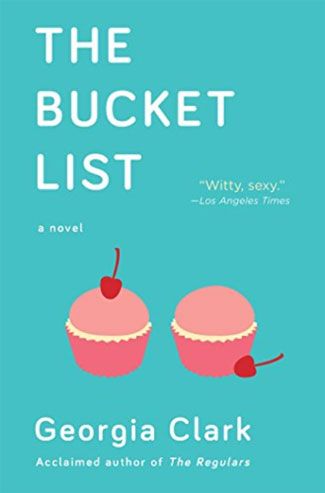
Introduction
This is the first work of fiction on breast cancer risk that we have reviewed. The protagonist, twenty-five year old Lacey Whitman, learns that she has inherited a genetic mutation that significantly elevates her breast cancer risk. Author Georgia Clark hails from Australia, has written three previous books and lives in Brooklyn. The author herself is not at risk from BRCA 1 or 2 and has not personally experienced preventative surgery. In her acknowledgements, she describes how she learned about this topic from peers who were really living with this risk and considering their options to have prophylactic mastectomies. The author spent time with nationally known experts in the field to increase her own understanding and inform her creative process. Knowing that the author did good quality research and had medical and other experts vet her writing means that, although the story and the characters are fictional, the embedded science and descriptions of procedures are reliable and, for someone in a similar real-life situation, they may even be useful. A funny work of fiction might be an easier way to absorb and work through a serious health situation than a more dry and scary work of non-fiction.
Structure of the Book
As a work of fiction, the book’s structure is more fluid that the memoirs and other non-fiction books we have reviewed previously. It progresses more or less chronologically over approximately 15 months and takes place in New York City.
Making sense of your mortality is not something most 21st century millennial denizens of the Big Apple (New York City) have many guideposts for doing.
Part 1: Chapters 1 – 6
We meet the central character Lacey Whitman in the middle of a busy work day early on in her career in the fashion industry. She gets the news from her doctor that she has tested positive for a genetic mutation that puts her at very high risk of breast cancer and needs to see a genetic counselor immediately to figure out what her options are. These first 6 chapters take the reader through the first hours, days and weeks of Lacey absorbing the implications of her test results. She is trying to learn as much as she can and figure out the best way to navigate the decision making process about whether and when to have a preventative double mastectomy (PDM). At the end of chapter 6, the decision has been made but a surgery date postponed for 6 months. Meanwhile Lacey sets out to create a bucket list of, and a plan for, a series of sexual exploration adventures before her breasts are permanently removed and replaced with ‘foobs’ - fake boobs.
Part 2: Chapters 7 – 56
During these chapters, the book could in some ways be a story about any hard working, hard playing, journey of self-discovery and some freewheeling experimentation channeling a kind of youthful defiance with inevitably some poor choices relationships along the way. Only in this case, there is the twist of cancer risk and life-saving, life-changing options (the preventative double mastectomy) constantly lurking in the background - or intruding into the present - as the source of the emotional and physical energy pulsing through these chapter. Through it, Lacey discovers how old friendships change (or not) and how new ones form. She grapples with being honest and with withholding information in relationships - and the consequences.
Part 3: Chapters 57-60
These four chapters cover the mastectomy, the post-operative drains, the pain, the medications, and the love and care of friends and family that support the protagonist in heartwarming and touching ways. In one scene her sister is helping her wash her hair for the first time and there is great tenderness between the siblings.
Finally Lacey is ready to see her foobs - fake boobs. Its’ not a pretty sight at first.
Little sparks of wry humor peek through, but in one sense Lacey has done more than had potentially life-saving surgery: she has transitioned into an older, wiser self even though she still speaks and uses social media like the 25 year old she is! As the book draws towards an end, Lacey prepares to post on Instagram using a goofy peace sign and the following typed message:
“Four days ago, I chose to have a PDM, which all the hip kids know means #preventativedoublemastectomy because I am #BRCA1 positive (Google it, nerds). I’m smiling because I knew when I woke up, I would FINALLY be free from the fear of getting breast cancer like my mom, the disease that ended her life at 31. But really, I was scared. I spent a lot of this year hiding that fear from the world and it made me feel pretty isolated. If you’re a BRCA1 babe, YOU ARE NOT ALONE. #Foobs #savingmyowndamnlife.” (page 329)
Lacey tags her cancer center and some other organizations before posting and then falling asleep. When Lacey wakes up she finds many new followers, supportive responses from friends and strangers alike and she realizes that the scared, alone and confused young lady is now fully back on social media with a new policy of radical honesty instead of carefully curated and sanitized content that had been her hallmark previously.
Later on Lacey’s sister Mara finally deals with her possible risk too and seeks genetic counseling and testing. To the relief of both sisters, Mara has not inherited the gene and Mara’s daughter Storm cannot be at risk either.
The book ends with Lacey resuming her life as a carefree 20-something well on her way to finding love and feeling whole enough with her foobs to move forward with a promising romantic relationship.
Conclusions and Recommendations
The author sets out to do something unusual with this work of fact-based fiction. That so much of the book is devoted to a six month period in the life of a 20 something year old woman who has given herself “permission” to be permissive might make it pulp fiction for a certain demographic. On the other hand, the time and trouble taken to get the details right about receiving and processing very important information about significant risk of a serious disease means that the author has created an exercise in “radical empathy” for her character which elevates this book out of the ordinary.
Medical fiction is an interesting genre. It is useful for exploring very fully the intersection between science and the human experience of absorbing and responding to information about what one’s genes may have instore for one's health. This book balances the serious with the irreverent in a way that makes for an enjoyable and fun read.
Review written by Rose Barlow, Executive Director, BRCA1 carrier and mother of a 21 year old BRCA 1 carrier (her older sibling tested negative for this inherited gene mutation).
This book has 343 pages.

